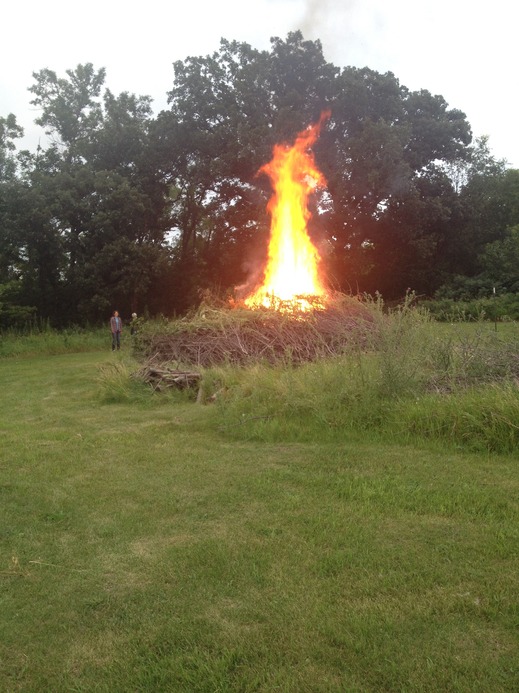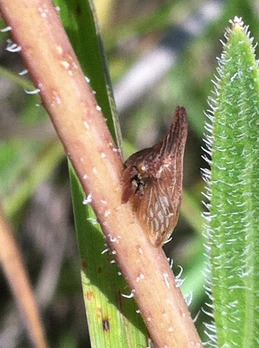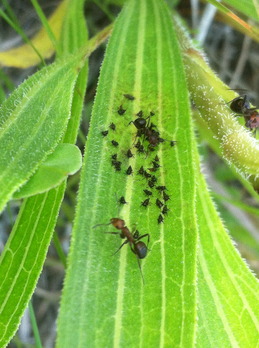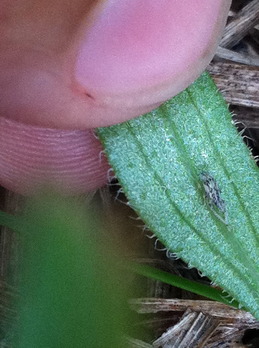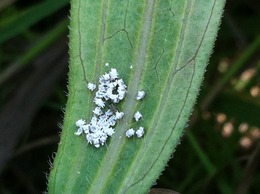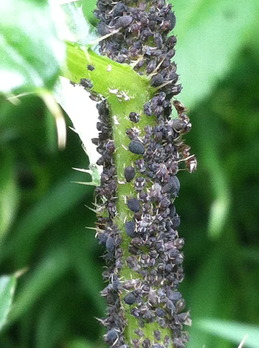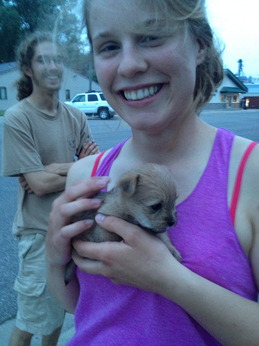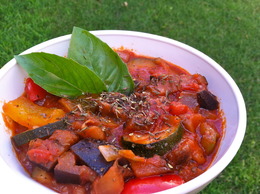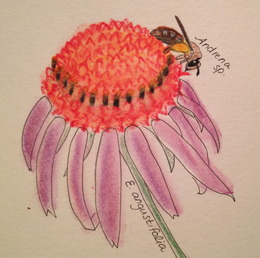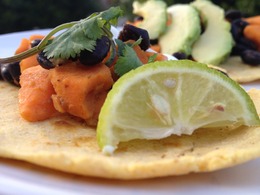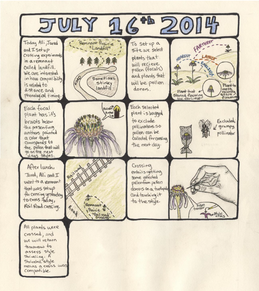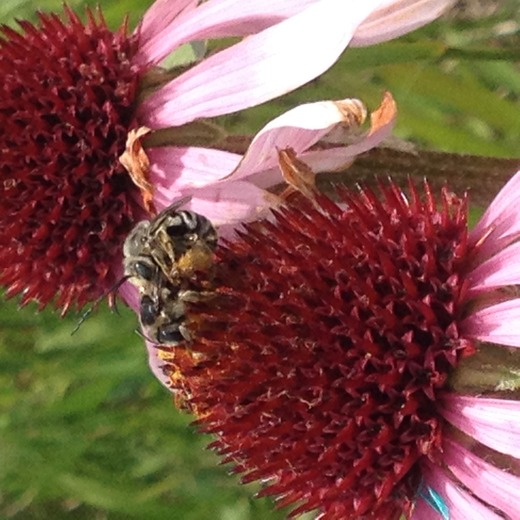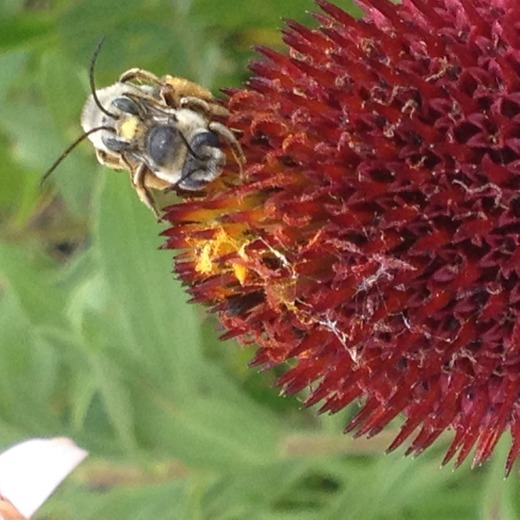|
|
Well Billy Joel, although your 1980’s classic hit is all too catchy, technically we did start this fire.

(Our massive fire. Claire for reference)
Over the past weekend, Team Echinacea decided to cap off a week of diligent work with a nice, relaxing potluck paired with an epic campfire. The food was delicious, but the company was even more enjoyable. Stuart and Gretel provided a delectable pesto, Jared and Claire (aka Clairred) prepared a tasty bean dip, and Maureen capped off the scrumptious meal with a cherry pie and a peach crumble that were to die for (not literally of course! That would be ridiculous). Following the feast, a fire was started to honor the great Echinacea Gods, which have blessed us with a prosperous flowering season and delightful weather. There was a little bit of difficultly starting the fire, but no problem is too large for a group of extremely bright scientists (at least that what we tell ourselves anyway). During the fire, Per, Hattie, Elizabeth, and I tested our luck at a friendly game of badminton. I paired up with Per while Elizabeth chose Hattie as her partner. What started as a friendly matchup, quickly turned into a competitive, all-out battle of the sexes! It wasn’t long before Hattie and Per were spiking shuttlecocks at each other while Elizabeth and I exchanged looks of distaste. Fortunately, the gruesome battle was cut short when Per spiked the birdie so hard that the rubber tip fully detached from the plastic base portion. I think it’s safe to say that this particular birdie won’t be flying again anytime soon. Although some harsh words were exchanged (all in good faith of course), at the end of the day, all conflict was left in the past as the team enjoyed roasted marshmallows over melty chocolate sandwiched between two yummy, graham crackers. And if you don’t enjoy S’mores, the only thing I have to say to you is “You’re killing me smalls!” (If you didn’t get that reference, then you need to go watch The Sandlot immediately. If you’ve never heard of The Sandlot, then I’m sorry but it’s too late to save you). All in all, it was a memorable weekend for the members of Team Echinacea.
Studying aphids on Echinacea requires looking much more closely than I would otherwise. Sure enough, the closer I look the more I see. Here are just a few of my discoveries (namely the ones I’ve made since learning how to make my phone take macro photos):
I’m assessing survival of aphids on different Echinacea species and hybrids in P7, an experimental plot at Hegg Lake. I also checked for aphids on the non-native E. pallida growing in a nearby restoration. As I expected, I didn’t find any Aphis echinaceae, but I did find this much larger phloem-feeder.

A nearby E. angustifolia didn’t have Aphis echinaceae either, but it did have ants tending a flock of a different species of insect.
One week after the first aphid addition, two of the plants in my experiment had this little gray thing on them (but no aphids). It seems to be an exoskeleton. I wonder if it belonged to the aphids or something else?

Gretel and I found this winged adult surrounded by “white fuzzies” (the technical term we use in our records) on a plant in P1 today. The leaf they were on looked diseased, with lighter coloring overall and purple venation.

Finally, here are some ants tending a humongous herd of generalist aphids on a thistle. A dowry fit for any ant princess!

The small town of Kensington received five new adorable puppies last week. After some sleuthing and chatting with the friendly locals, team Echinacea received the chance for some much needed puppy playtime.

But what’s more exciting than puppies? Proposals and updated procedures!
Pollinator Efficiency Proposal 2014 .doc
Pollinator Efficiency Procedure.doc
PolObDatasheet_2014.xls
Attached to this post you will find team pollinator’s original proposal as well as an updated procedure and an updated datasheet. The past three weeks have flown by and we have already conducted observations on 175 heads! This means that we are only 25 heads short of our goal just in time for the end of flowering. It is also amazing how much we have learned and how much we have had to change our procedure. I hope that someone will pick up this project next summer and this updated information will help them to avoid some of the problems we’ve encountered.
In other exciting news, tonight I cooked Ratatouille for the team. Thank you Gretel and the Wagenius garden for the delicious basil!

My favorite French dish + my favorite people = the perfect end to a relaxing Sunday.
In case you’re missing the exciting happenings at Staffanson Prairie Preserve, here’s the first issue of The Staffanson Almost Weekly. This periodical will keep you up to date on the new plant of the week, a plant that is nearing the end of it’s flowering period, and one that will most likely begin to bloom in the next week (all voted on by Claire and Jared). There are also some other exciting tidbits about current experiments and other interesting sightings.
-Claire

We started off the morning working on independent projects, collecting and relocating aphids in P1 and doing phenology in P1. A few of us headed out to Hegg lake before lunch to help Amy search for plants in her plot dedicated to her local adaptation study. As we worked we could see the sky darken to the west, and right before we headed in for lunch we heard the first clap of thunder. Our plans to begin measuring Echinacea in P1 for the afternoon were thwarted by the storm. We spent the afternoon doing data entry and tidying up around the Hjelm house before we headed out for the day.

We spent the morning working on our personal projects. Elizabeth assessed style shriveling on her crossed flowers at Yellow Orchid Hill, where, she reports, flowering has recently passed its peak. Meanwhile, Claire and Jared performed crosses on the focal plants on the west unit of Staffanson. In P1, Will worked on his pollen preservation experiment and the Pollinator Posse (Keaton, Maureen, and Jennifer) surveyed P1 phenology. Further afield, Alli continued her flowering community analysis.
But the real action was at Hegg Lake, where I finished my first round of aphid additions to Echinacea angustifolia, E. pallida, and their hybrids in P7. I have almost doubled my efficiency since starting the additions, performing 20 additions in a little over an hour. I also surveyed the phenology of the 18 E. pallida flowering in the restoration nearby. Aphid survival and flowering phenology may seem pretty disparate topics–and they are–but they both inform our understanding of the consequences of introducing a non-native but closely related Echinacea species. Do they support the same aphids? How about their hybrids? How likely are they to hybridize? How much does their flowering phenology overlap? It’s hard to stick to just one question.
Doubtless inspired by my example, the rest of the team came to Hegg in the afternoon, where we measured plants in P2. Many of us we were able to increase our efficiency by working alone instead of in pairs, and row by row we progressed eastward. Less than an afternoon’s work remains.
With nearly all of our plants mapped at Staffanson, Claire and I have taken a little sneak peak at the spatial data we collected (it’s like Christmas in July, we just couldn’t wait to open our presents). I have included a graph depicting the the average distance from each flowering Echinacea plant to its kth nearest neighbor. The distribution of distances were nearly all skewed right so I plotted the natural log-transformed distances +/- the SE. There are clear differences between the East and West units (note that the East unit was burned in 2014).
knnspp2014.pdf
Although this graph does not necessarily reflect distances to the true nearest flowering neighbors (we only included distances for plants mapped on our sampling transect), these data are consistent with our hypothesis that fire increases the density of flowering Echinacea. More to come soon…
The field season is heating up for Team Echinacea both literally and metaphorically. Much of the metaphorical heat comes from the awesome work everyone has been putting into group and independent projects. However, a small portion of this heat also comes from a budding relationship between Andrea and I that was sparked at experimental plot 2 a week ago. On my day off, I missed her so much I simply had to draw a picture of her.

Why is Andrea so special to me? One important reason is that she is an Andrena bee and Andrena seem to be the most efficient pollinators of Echinacea angustifolia based on our preliminary findings. Another reason is that she is absolutely adorable and very photogenic.

Aside from missing Andrea, I also made dinner for the team. I decided on sweet potato black bean tacos with homemade tortillas. Mmmm…..

With Echinacea’s flowering reaching its peak, there isn’t a better idiom to describe the team’s work schedule for the week. Remnant phenology, independent projects, and a large scale compatibility project are just a few of the tasks being carried out on a regular basis. As for the pollinator project Maureen and I have been working on, things are going great. After alternating back and forth between P1 and P2, we have accumulated over 60 observations, which is a little over half of what we are aiming for. Towards the beginning, we saw mostly small green bees, but recently we have started seeing more and more of the larger bees, such as Melisodes and Andrena. For example, we added 7 more Andrena observations just today, which more than tripled the Andrena observations we had up to this point. Things may be a little hectic at Team Echinacea headquarters, but this doesn’t mean we are all work and no play. Just tonight we enjoyed a post work bonfire with s’mores, badminton, and croquet. You might even say it was the…… bee’s knees!
And just in case this post didn’t contain enough corny pollinator references, here’s a couple of pictures of a pair of Melisodes teaching us a lesson about the Birds and the Bees.


|
|

